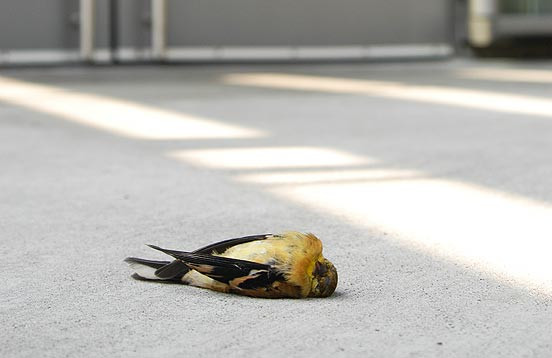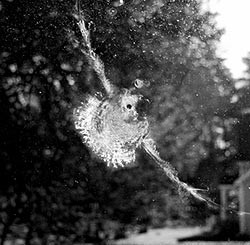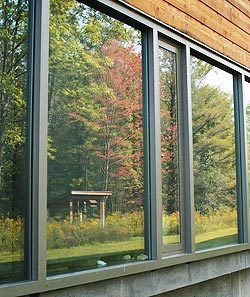Window collisions are a significant threat to bird populations. It might seem counterintuitive, but glass windows, designed to bring the outdoors in, are often deadly obstacles for birds. Reflecting sky and vegetation, windows appear as open flyways, leading to an estimated one billion bird deaths annually in the U.S. alone, according to a 2014 study.
Fortunately, simple actions can drastically reduce this danger around your home. Christine Sheppard, who leads the Bird Collisions Program at the American Bird Conservancy, emphasizes that practical solutions are readily available. Organizations like the American Bird Conservancy and the Fatal Light Awareness Program (FLAP) offer comprehensive resources on preventing these collisions.
 american goldfinch killed by window strike
american goldfinch killed by window strike
Image: American Goldfinch, a victim of window strike, highlighting the danger windows pose to birds.
Even if a bird seems to recover after hitting a window and flies away, the impact can be fatal. Internal injuries, particularly brain trauma, are common and often lead to delayed death. As researcher Daniel Klem, who has studied this issue extensively, notes, windows are indiscriminate killers, affecting healthy and vulnerable birds alike.
Understanding Why Birds Hit Windows
 imprint of dove on plate glass window
imprint of dove on plate glass window
Image: Window imprint left by a Mourning Dove, illustrating the force of bird window collisions.
Bird window collisions are categorized into two main types: daytime and nighttime.
Daytime Collisions: During the day, birds primarily collide with windows because they perceive reflections of surrounding greenery or see through the glass to indoor or outdoor vegetation. The reflected habitat creates an illusion of continuous open space, leading birds to fly directly into the glass.
Nighttime Collisions: Nocturnal migrating birds, including many songbird species, are vulnerable to nighttime collisions. Artificial lights, particularly in urban environments, disorient these migrants, especially under low cloud cover or foggy conditions. Drawn to brightly lit areas, birds can become trapped and collide with illuminated structures and windows. Furthermore, birds attracted to urban lights at night may face daytime collision risks as they encounter reflective windows the following day. Projects like BirdCast and FLAP are actively addressing this issue of light pollution.
Another, less frequent, cause of window strikes occurs when birds see their own reflection and mistake it for a rival, especially during the spring breeding season when territorial behavior is heightened. While this behavior can be bothersome, it rarely results in serious injury to the bird. Many of the solutions for general window strike prevention are also effective in deterring these territorial attacks.
Effective Methods to Bird-Proof Your Windows
 reflection of foliage in window – hazard to birds
reflection of foliage in window – hazard to birds
Image: Reflection of trees and sky in a window, demonstrating how these reflections become invisible barriers for birds.
The first step in preventing bird collisions is to identify hazardous windows. Large picture windows, corner windows, and windows near bird feeders are particularly risky. To assess your windows from a bird’s perspective, go outside and observe them. If you see reflections of trees, bushes, or sky, or if you can see through the window to plants on the other side, these windows pose a collision risk. Contrary to older advice about feeder placement, Christine Sheppard advises focusing on making windows bird-safe rather than worrying about feeder distance. “If you’ve got windows near a bird feeder, you should make them bird friendly and don’t worry about how far away they are.”
Here are practical treatments for existing windows and considerations for new construction to minimize bird collisions:
Solutions for Existing Windows
For smaller birds, window markings should ideally have consistent spacing of 2 inches or less across the exterior glass surface. This spacing is crucial for protecting even the smallest bird species like hummingbirds and kinglets. Acopian BirdSavers, utilizing paracord, can be spaced up to 4 inches apart due to their enhanced visibility. Remember, all treatments must be applied to the outside of the window to be effective.
- Temporary Paint or Soap: Applying tempera paint or soap to the exterior of windows is a budget-friendly and durable solution. Create a grid pattern with 2-inch squares or explore creative designs.
- Window Decals and Stickers: Apply decals, stickers, sun catchers, mylar strips, masking tape, or even sticky notes to the outside of the window. Close spacing is key for effectiveness. It’s important to note that hawk silhouettes alone are not effective bird deterrents. Simply placing a few stickers on a large window is insufficient; coverage must be extensive, with minimal gaps for birds to fly through.
- Dot Patterns and Specialized Tapes: Long-lasting tapes with pre-spaced dot patterns offer a convenient way to achieve proper spacing. Products like Feather Friendly are designed specifically for bird collision prevention.
- Acopian BirdSavers (Zen Curtains): These hanging cords, also known as zen curtains, are spaced closely together and hang vertically over windows. They provide effective coverage similar to tapes or decals but are easier to install and can be aesthetically pleasing. The Cornell Lab of Ornithology headquarters utilizes Acopian BirdSavers to protect its windows. They can be purchased pre-made or DIY versions can be created.
- Window Screens: Installing mosquito screens on the exterior of your windows is a highly effective method, provided they cover the entire window surface.
- Netting: Covering windows with netting on the outside, positioned at least 3 inches away from the glass and taut enough to deflect birds, is another robust solution. Small-mesh netting (around 5/8″ or 1.6 cm) is ideal to prevent entanglement and ensure birds bounce off safely. Netting can be mounted on frames for easier installation and removal, similar to storm windows.
- One-Way Transparent Films: Films like Collidescape are designed to allow outward visibility from inside while making the window appear opaque from the outside. These films can also reduce incoming light, potentially lowering cooling costs.
Design Considerations for New Homes and Remodeling
For new construction or window replacements, consider these preventative measures:
- Exterior Shutters: Install external shutters and close them when rooms are unoccupied or when natural light and views are not desired. Shutters also offer significant energy-saving benefits.
- External Shades and Awnings: Install exterior sun shades or awnings to minimize sunlight reflection. Remote-controlled options provide added convenience.
- Window Design: Opt for window designs that incorporate external screens across the entire glass surface.
- Interior Vertical Blinds: Utilize interior vertical blinds and keep slats partially closed to break up reflections.
- Minimize Visual Pathways: Avoid creating unobstructed visual paths through your home to outdoor greenery or sky. Windows on opposite walls that align can create the illusion of a clear passage. Closing interior doors or using window shades can mitigate this effect.
Lights Out Initiatives
“Lights Out” programs are gaining momentum across numerous U.S. cities, including major urban centers like New York City, Dallas, and Philadelphia. Excessive nighttime lighting from office buildings and streetlights is a major hazard for migrating birds, disrupting their navigation, delaying migrations, and increasing their vulnerability to window collisions. Implementing “Lights Out” practices, such as turning off unnecessary lights and using downward-facing lighting fixtures, are simple yet impactful steps to reduce light pollution at night. Even with community-wide efforts, individual homeowners should still employ window collision prevention methods.
How to Assist a Bird Injured in a Window Collision
If you find a bird that has collided with a window, immediate assistance significantly improves its chances of survival. Window strike victims may suffer internal injuries that are not immediately apparent but can worsen over time. They are also vulnerable to predators and other hazards. Here’s how to help:
- Capture and Contain: Approach the bird cautiously from behind and gently cup it with both hands. The bird may flutter or vocalize. Handle small birds delicately, ensuring your grip is secure but not too tight.
- Prepare a Container: Find a suitable container like an unwaxed paper bag or a small cardboard box lined with tissue paper or paper towels to provide grip. Place the contained bird in a dark, quiet, warm, and safe location away from children and pets.
- Do Not Feed or Water: Avoid handling, feeding, or watering the bird while it is in the container. Wild birds perceive humans as threats, and minimizing stress is crucial.
- Contact a Wildlife Rehabilitator: Locate a wildlife rehabilitator near you using an online directory. Contact them for guidance and instructions. If you cannot transport the bird, inform the rehabilitator, as they may offer alternative solutions.
- Release Instructions (If Advised): If the rehabilitator instructs you to release the bird, take it to a wooded area or appropriate habitat away from buildings. Before release, observe its flight ability by opening the container in the direction of vegetation. If the bird’s flight is weak or unsteady, recapture it and contact the rehabilitator for further assistance.
By implementing these preventative measures and knowing how to assist injured birds, you can make a significant difference in protecting birds from the dangers of window collisions.